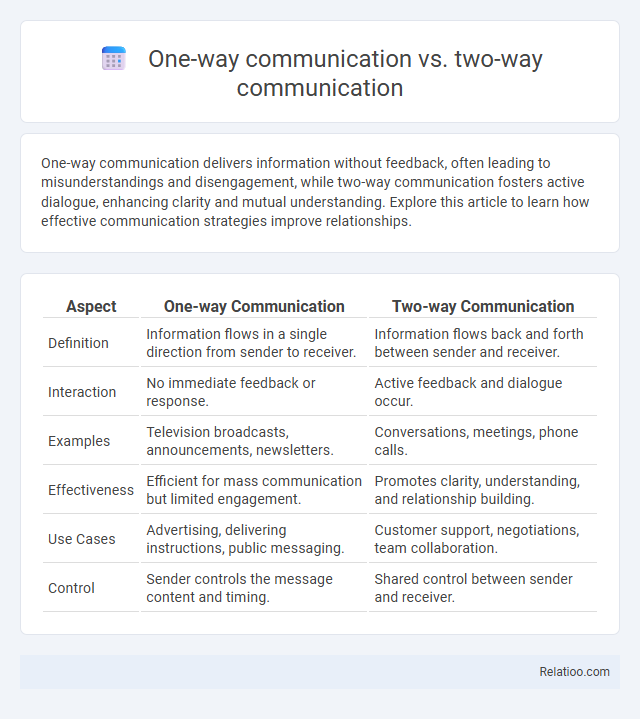One-way communication delivers information without feedback, often leading to misunderstandings and disengagement, while two-way communication fosters active dialogue, enhancing clarity and mutual understanding. Explore this article to learn how effective communication strategies improve relationships.
Table of Comparison
| Aspect | One-way Communication | Two-way Communication |
|---|---|---|
| Definition | Information flows in a single direction from sender to receiver. | Information flows back and forth between sender and receiver. |
| Interaction | No immediate feedback or response. | Active feedback and dialogue occur. |
| Examples | Television broadcasts, announcements, newsletters. | Conversations, meetings, phone calls. |
| Effectiveness | Efficient for mass communication but limited engagement. | Promotes clarity, understanding, and relationship building. |
| Use Cases | Advertising, delivering instructions, public messaging. | Customer support, negotiations, team collaboration. |
| Control | Sender controls the message content and timing. | Shared control between sender and receiver. |
Introduction to Communication Models
One-way communication delivers messages without feedback, making it ideal for clear, concise information transmission. Two-way communication involves an interactive exchange, allowing feedback that enhances understanding and collaboration. Your grasp of these models is crucial for recognizing the value of connection, where mutual influence and shared meaning create deeper engagement.
Defining One-Way Communication
One-way communication involves delivering a message from a sender to a receiver without expecting or allowing immediate feedback, commonly used in broadcasting or announcements. It is effective for disseminating information quickly to a large audience but limits interaction and engagement. Understanding this can help you choose the appropriate communication style to meet your specific needs, especially when immediate response is unnecessary.
Defining Two-Way Communication
Two-way communication involves an interactive exchange where both parties actively send and receive messages, ensuring feedback and clarification in real time. Unlike one-way communication, which flows in a single direction without immediate response, two-way communication fosters understanding and collaboration by enabling dialogue and mutual adjustment. Your ability to engage in two-way communication strengthens relationships, enhances problem-solving, and creates meaningful connections.
Key Differences Between One-Way and Two-Way Communication
One-way communication involves a sender transmitting information to a receiver without expecting feedback, often seen in lectures or advertisements, whereas two-way communication encourages active interaction and feedback, such as in conversations or meetings. Your understanding improves with two-way communication as it allows clarification, engagement, and adaptation of messages based on responses. Connection emphasizes the mutual exchange and relationship building that arises primarily through two-way communication, enhancing trust and collaboration significantly.
Advantages of One-Way Communication
One-way communication allows for clear and efficient dissemination of information, ensuring your message reaches a wide audience without distortion or feedback delays. It is ideal for announcements, instructions, and emergency alerts where consistency and speed are critical. This method minimizes misunderstandings by controlling the flow, making it a reliable tool for managing large-scale communication needs.
Advantages of Two-Way Communication
Two-way communication enhances collaboration by enabling real-time feedback, fostering mutual understanding, and reducing errors in information exchange. Unlike one-way communication, it promotes active engagement, encourages idea sharing, and strengthens relationships between participants. This interactive process leads to improved decision-making and increased trust within teams and organizations.
Limitations of One-Way Communication
One-way communication limits your ability to receive feedback, creating potential misunderstandings and reduced engagement by providing information without interaction. This form causes inefficient information flow, as the sender cannot gauge the recipient's comprehension or response, leading to missed opportunities for clarification and collaboration. Two-way communication and connection foster dialogue and mutual understanding, enhancing relationship-building and problem-solving beyond the constraints of one-way transmission.
Limitations of Two-Way Communication
Two-way communication allows interactive exchanges but is often limited by time constraints, potential misunderstandings, and the need for active participation from all parties. Unlike one-way communication, which efficiently disseminates information without requiring immediate feedback, two-way communication demands more resources and can be less effective in large-scale broadcasts. Connection represents a deeper, ongoing relational engagement that transcends the transactional nature of two-way communication, fostering trust and sustained interaction.
Real-World Examples: One-Way vs Two-Way Communication
One-way communication is exemplified by traditional media like television broadcasts and public announcements, where information flows from sender to receiver without feedback. Two-way communication occurs in customer service interactions and team meetings, enabling real-time feedback and dialogue that enhance understanding and collaboration. Connections in digital platforms such as social media combine both forms, facilitating initial one-way content sharing followed by two-way engagement through comments and discussions.
Choosing the Right Communication Method for Your Needs
One-way communication delivers information from sender to receiver without feedback, ideal for clear, directive messages, while two-way communication involves interaction and feedback, fostering collaboration and understanding. Connection emphasizes building rapport and engagement beyond message exchange, crucial for relationship-driven goals. Choosing the right communication method depends on Your need for clarity, interaction, or relationship building to optimize effectiveness and achieve intended outcomes.

Infographic: One-way communication vs Two-way communication
 relatioo.com
relatioo.com